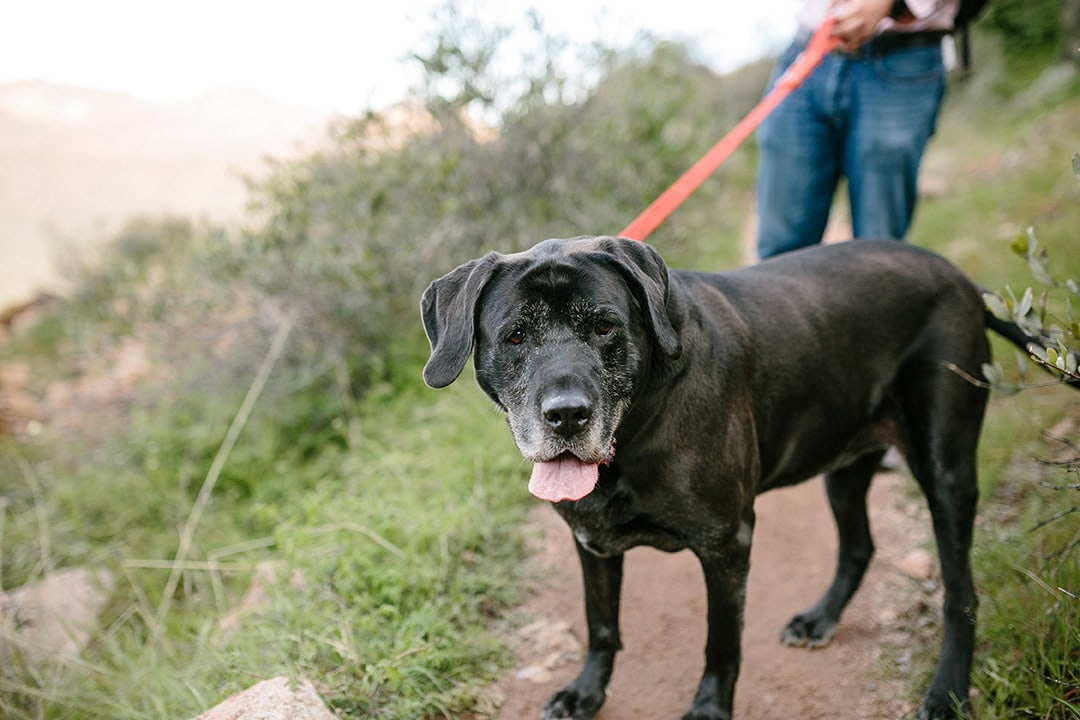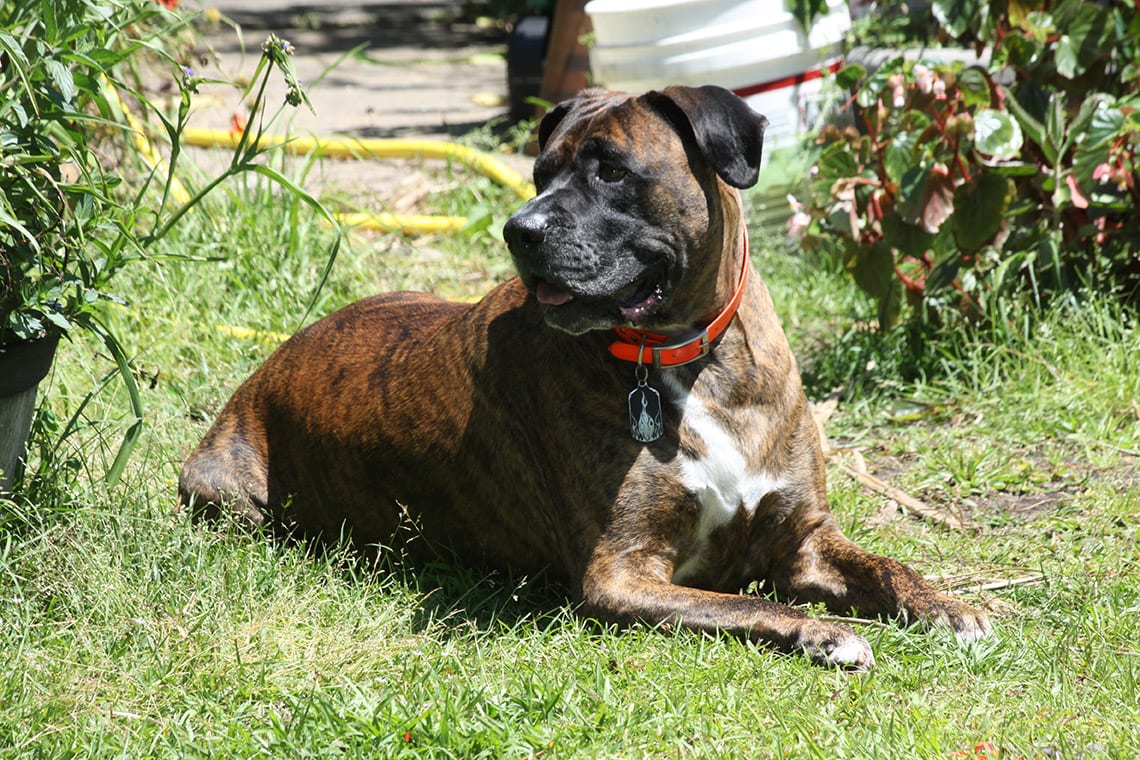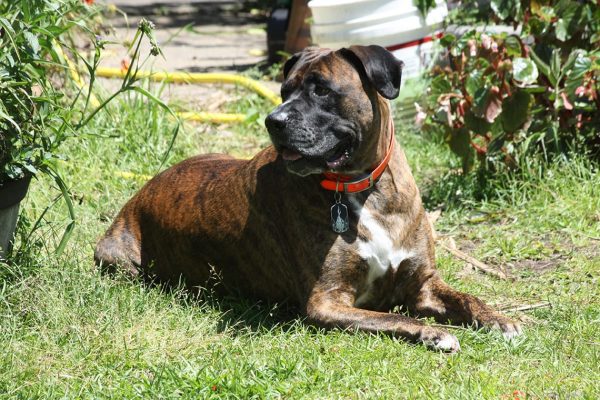Mastiffs are huge, dependable breeds. However, when you mix them with another breed, you can end up with a unique hybrid. Often, their puppies are larger than most dogs and may even fall into the “giant” category. However, that isn’t always true.
When you cross two breeds together, you never quite know what you’re going to get. The puppies can inherit traits from either parent breed, which means that they can favor either parent in any way. Depending on the exact traits at play, some may not even look like a Mastiff. However, many mixed breeds seem to inherit the same general traits. In this article, we’ll take a look at some of the most popular Mastiff mixed breeds and the traits that they typically have.

Top 16 Mastiff Mixes:
1. Mastiff Golden Retriever Mix (Golden Retriever x Mastiff)
Given the Golden Retriever’s popularity, there is no question why this is one of the most popular Mastiff mixed breeds. Typically, mixing a Mastiff with a Golden Retriever results in a puppy that is more energetic and friendly than a purebred Mastiff. However, they still usually have some territorial instincts, which can be challenging for some owners to handle.
Often, the Mastiff Goldern Retriever is smaller than a Mastiff. Exactly what size they will be varies widely, though. It is possible for them to be at the lower end of the Golden Retriever range or the upper end of the Mastiff range. As a mixed breed, they may be healthier than either of their parents. They may have a slightly longer lifespan as well, simply because they don’t have to deal with as many health problems.
2. Mastiff Presa Canario (Presa Canario x Mastiff)
The Presa Canario was originally bred to protect their owners against wild dogs, and the Mastiff was bred as a protection animal. Therefore, when you put them together, the Mastiff Presa Canario retains some of the parents’ traits and may be a skilled guard dog.
Most are smaller than a Mastiff, though that isn’t always the case. Due to their protective nature, they need quite a bit of socialization at a young age to remain accepting of strangers and dogs. Generally, they are only recommended for those who are looking for a guard dog. Although the Mastiff Presa Canario can be difficult to handle, their abilities as a guardian dog are top-notch.
3. Mastador (Labrador Retriever x Mastiff)

When you combine a Mastiff with a Labrador Retriever, you end up with a Mastador. They can be incredibly friendly or aloof and distant. It depends on the traits they inherit from their parents. The traits of the Labrador Retriever often temper the Mastiff in more than one way. Mastadors are usually friendlier than purebred Mastiffs and a bit smaller as well.
They are more sociable than other Mastiff hybrids but still require early socialization. They have some protective instincts, even if they aren’t as strong as a purebred Mastiff. Therefore, it is important to temper these instincts with plenty of socialization and training at a young age.
4. Mastibull (American Pitbull Terrier x Mastiff)
Breeding a Mastiff with an American Pitbull Terrier results in the “Mastibull” or “Pit Mastiff.” Either way, this dog is usually more energetic and outgoing than a Mastiff. Despite some common misconceptions, the American Pitbull Terrier isn’t very protective. Instead, they are very hyperactive and outgoing.
The Mastibull is likely to develop some of these traits. They can be a bit less aloof than the Mastiff, but probably not as laidback as them, either. Where they fall on this scale depends on the traits they inherit and how well they are socialized as a puppy. This mixed breed can vary widely due to the differences between the two parents.
Mastibulls dislike being left alone due to the strong bonds they form with their owners. For this reason, they may be prone to isolation anxiety.
5. Mastiff Bernese Mountain Dog (Bernese Mountain Dog x Mastiff)
Both the Mastiff and Bernese Mountain Dog are fairly large canines. The Mastiff Bernese Mountain Dos is likely to be extremely large as well, so ensure that you have the room available before you adopt one. They can be long-haired or short-haired; the Mastiff carries a long-haired gene that is usually recessive. The Bernese Mountain Dog can bring out this gene and leave you with a long-haired dog that requires intensive daily grooming.
The Mastiff Bernie may have some protective instincts, but they’re generally friendly. It depends on the traits each dog inherits, as well as the socialization they receive as a puppy. We highly recommend this dog for those who are experienced with handling larger breeds.
6. Mastiff Great Pyrenees (Great Pyrenees x Mastiff)
Because both of these breeds are larger, you typically end up with much larger puppies. The smallest Mastiff Great Pyrenees dogs weigh over 80 pounds, and the largest dogs can be well over 100 pounds. Their hair is often long and white, though you can end up with a puppy with nearly any coat type. They require quite a bit of grooming, so we recommend only adopting this breed if you have plenty of time on your hands. These dogs shed a lot.
The Mastiff Great Pyrenees will have protective instincts, though the extent can vary quite a bit. To counteract this, we recommend plenty of socialization and training from a young age. These dogs can be less protective than their Mastiff parent, however.
No matter their inherited traits, they tend to be laid back and require very little exercise. They can easily be described as “rug dogs” due to their tendency to lay on the floor like a rug for much of the day.
7. Mastiff American Bulldog Mix (American Bulldog x Mastiff)
Often, the Mastiff American Bulldog mix can be protective. They are aloof toward strangers, though they can be very friendly to their families. They are also obedient in some cases but can also be stubborn. Training and socialization are recommended starting at a very young age, ensuring you’re prepared for anything.
The Mastiff American Bulldog dog usually isn’t very active. They love to cuddle with their family but typically don’t require much exercise. Still, it is important to regularly exercise them to prevent obesity and keep them healthy. Some can be a bit energetic, especially as puppies. Like people, some dogs are simply more hyperactive than others.
Their coat is usually short and smooth, and they can inherit the black face mask, or they may not. They are large dogs that need plenty of space to stretch out and are not suitable to keep in a small apartment.
8. Mastweiler (Rottweiler x Mastiff)
If you want a serious guarding dog, the Mastiff and Rottweiler mix may be the way to go. Both of their parents were bred for protection, and the Mastweiler will have protective instincts. They can be more protective than most of the other dogs on this list, so we typically only recommend them for those who are actively seeking a protection canine. They need a lot of training and socialization.
Luckily, they are pretty easy to train and don’t usually have stubborn phases. This makes them much easier to deal with than other canines. They are massive canines, and the largest ones can weight up to 200 pounds. They need a lot of space, even though they aren’t very active. They simply need a lot of room to lay down in.
They can be affectionate with family and rather laid back until someone they don’t know comes by.
9. Mastiff Greyhound Mix (Greyhound x Mastiff)
Truthfully, this hybrid is a bit odd. The combination of a burly, heavy-set Mastiff and a quick-footed Greyhound can leave you with just about anything. Mastiff Greyhounds are bulkier than a Greyhound but skinnier than a Mastiff. Where exactly they fall varies widely. They’re not very active but incredibly strong.
Mastiff Grehounds are relatively healthy, but their diets must be monitored closely to ensure they don’t gain too much weight. This dog may have guarding instincts, though they are generally less prominent than those of a purebred Mastiff. They can make excellent family dogs, but they need early socialization and training.
10. Mastiff Irish Wolfhound (Irish Wolfhound x Mastiff)
If you want the largest of the Mastiff hybrids, adopt this mixed breed. Both the Mastiff and the Irish Wolfhound are massive canines. When you mix them together, you end up with a relatively large dog. The Mastiff Irish Wolfhound is usually well-behaved and doesn’t have too many behavioral problems. They can be protective but not to the degree of a purebred Mastiff. Still, we recommend socialization at an early age to make them tolerate strangers and other canines.
Although they’re giant, they act like lap dogs and don’t seem to know how massive they are. They’re gentle with children and are usually easygoing pets. They aren’t energetic enough to knock children down accidentally in most cases.
11. Mastiff Shepherd (German Shepherd x Mastiff)

In some cases, the Mastiff and German Shepherd mix can be the perfect guard dog. In other cases, they can simply be a lot to handle. Most Mastiff German Shepherds are very protective of their family and home. Because of their larger size, they can be difficult to control without correct training. Therefore, we recommend these dogs only for those who can commit to plenty of training time and socialization. If you’re looking for a guard dog, this may be an appropriate option.
The Mastiff German Shepherd is relatively easy to train and more than willing to please their owners. However, without training, these dogs can be dangerous.
They’re affectionate around their owners and incredibly energetic. They need a bit more exercise than you would expect.
12. Mastiff Great Dane Mix (Great Dane x Mastiff)
The Mastiff Saint Bernard is one of the tallest dogs on this list. Sometimes, they can even reach up to 200 pounds. Sadly, this excessive weight puts a lot of strain on their joints and can make them relatively unhealthy. They have a shorter lifespan than other dogs simply because their bodies are under more strain.
They can come in just about any color, depending on the coloration of their parents. They will have a black facial mask, though other markings are completely possible as well. Their ears are floppy, and they may drool, especially if they take after their Mastiff parent.
They get along well with children and are patient with them if they are too rough.
13. Mastiff Saint Bernard Mix (Saint Bernard x Mastiff)
Saint Bernards are well-known for being great family dogs. The Mastiff Saint Bernard also gets along with adults and children but can have some of the guarding instincts that their Mastiff parent has. They tend to spend much of their day lounging around and not doing much. They don’t have high activity needs, so they are typically easy to exercise with brief play sessions and short daily walks.
While they may not be very accepting of strangers, they love their family and are very affectionate. They are well-known for being good with children. They can tolerate a smaller child’s excited nature, and they’re incredibly patient.
14. Mastahoula (Catahoula Leopard Dog x Mastiff)
This interestingly named mixed breed is a cross between a Mastiff and a Catahoula Leopard Dog. The Mastahoula is one of the rarer dogs on this list, but that doesn’t mean that they’re impossible to find. They are very intelligent, and they thrive when given a job to do. They are working dogs and need plenty of daily exercise to keep them happy.
However, they will cuddle on the couch and are affectionate with their family. Masahoulas can weigh 75 to 175 pounds, but their adult weight depends on which traits they inherit. It can be difficult to determine how large a puppy might grow Prepare for a larger dog, but you may end up with a slightly smaller one.
15. Mastiff Boxer Mix (Boxer x Mastiff)

When you mix a Mastiff and a Boxer together, you get a large, muscular canine. They can weigh over 75 pounds, and they can be bulk like the Mastiff or athletic like the Boxer. Unlike the Mastiff, they are playful and energetic. They can be comical due to their noisy and boisterous personality. You should plan on providing plenty of exercise each day. However, don’t force them to exercise excessively, which can cause joint problems.
Mastiff Boxers can be difficult to train. The Mastiff’s stubbornness, combined with the Boxer’s inability to concentrate, makes training challenging, but you can get professional help to train them faster and more effectively.
16. Mastiff Husky Mix (Siberian Husky x Mastiff)
The Mastiff and Husky are very different dogs, so their mixed-breed puppies can display unique behaviors. They may be more calm like the Mastiff or more energetic like the Husky. They likely won’t be hyperactive, but they may run around very excitedly for 10 minutes and then spend a few hours sleeping. They tend to play hard and then crash.
Although they are smart, Mastiff Huskies don’t dedicate their intelligence to their training. They are incredibly stubborn and have difficulty applying what they know to new situations. It is common for them to learn the command perfectly in training class and then have no idea what you’re talking about when you give them the command at home.
For this reason, we only recommend them for those who have plenty of time to train. Otherwise, they can quickly become out of control and be more of a handful than you’re willing to deal with.
Final Thoughts
Any time you cross a breed with a Mastiff, they will probably inherit some of the guarding instincts at least some degree. If you’re looking for a guard dog, a Mastiff hybrid may be ideal. However, if you aren’t, you’ll likely spend plenty of time socializing and training your dog. Some of these dogs are aloof with strangers. But you never can tell what you’re going to get. Therefore, it is best to be safe rather than sorry and provide plenty of socialization opportunities.
Most of these mixed breeds are not as large as the Mastiff, but they still all fall into the large category. No puppy with a Mastiff parent is going to be small. You should plan on a larger dog, especially since many of these breeds can easily top 100 pounds. Some can even get close to reaching 200 pounds.
Many of these breeds vary widely, and the temperament and appearance of the puppy will not determine what they will be like as an adult. You can expect an incredibly large dog with guarding instincts that will protect your family from harm.
See also:
Featured Image Credit: Deonna Carroll, Shutterstock
Contents
- Top 16 Mastiff Mixes:
- 1. Mastiff Golden Retriever Mix (Golden Retriever x Mastiff)
- 2. Mastiff Presa Canario (Presa Canario x Mastiff)
- 3. Mastador (Labrador Retriever x Mastiff)
- 4. Mastibull (American Pitbull Terrier x Mastiff)
- 5. Mastiff Bernese Mountain Dog (Bernese Mountain Dog x Mastiff)
- 6. Mastiff Great Pyrenees (Great Pyrenees x Mastiff)
- 7. Mastiff American Bulldog Mix (American Bulldog x Mastiff)
- 8. Mastweiler (Rottweiler x Mastiff)
- 9. Mastiff Greyhound Mix (Greyhound x Mastiff)
- 10. Mastiff Irish Wolfhound (Irish Wolfhound x Mastiff)
- 11. Mastiff Shepherd (German Shepherd x Mastiff)
- 12. Mastiff Great Dane Mix (Great Dane x Mastiff)
- 13. Mastiff Saint Bernard Mix (Saint Bernard x Mastiff)
- 14. Mastahoula (Catahoula Leopard Dog x Mastiff)
- 15. Mastiff Boxer Mix (Boxer x Mastiff)
- 16. Mastiff Husky Mix (Siberian Husky x Mastiff)
- Final Thoughts











